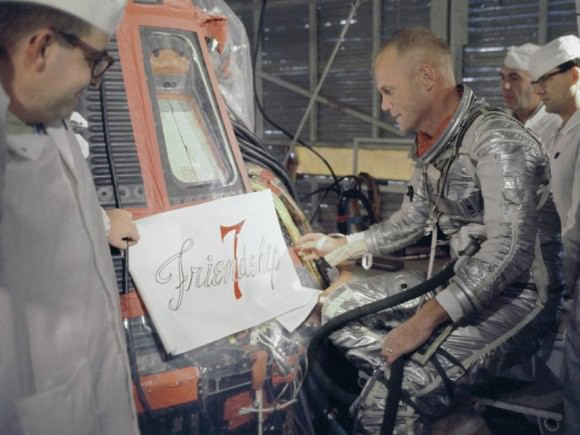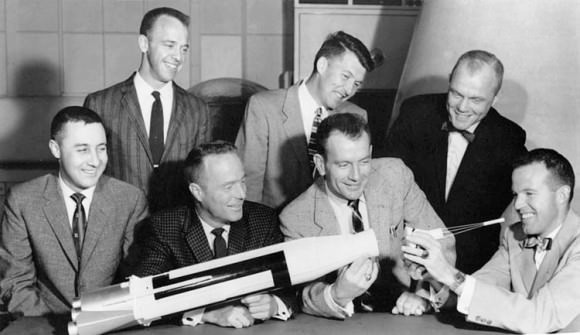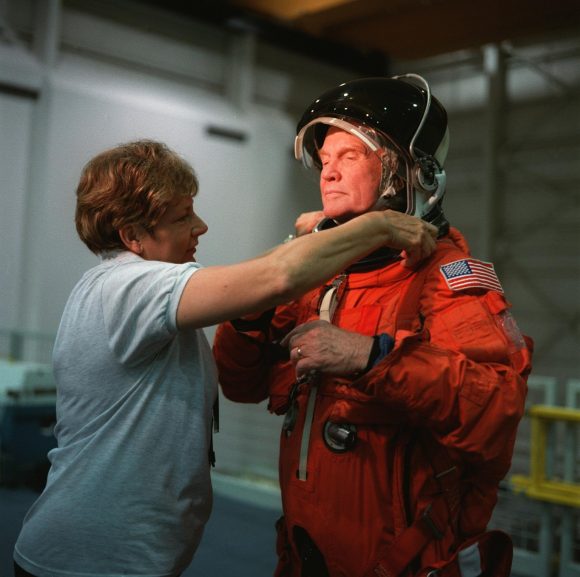Legendary astronomer Frank Drake has passed away at the age of 92. Known primarily for his Drake Equation — an estimate of the probability of intelligent extraterrestrial life — he pioneered the field of SETI, the Search for Extraterrestrial Intelligence, and was a noted astronomer and astrophysicist. His work and life have left an indelible mark on humanity and given hope and wonder to all our hearts.
Continue reading “Legendary Astronomer Frank Drake has Passed Away”John Glenn: Godspeed and Rest in Peace
John Glenn always had the right stuff.
Glenn, the first American astronaut to orbit the Earth and a legendary figure around the world, has died. Glenn, 95, was the last remaining Mercury astronaut, the first group of US astronauts. He flew on Friendship 7 on Feb. 20, 1962, and later flew on the space shuttle in 1998 at age 77, becoming the oldest astronaut to fly in space. He also spent 24 years as a U.S. Senator from Ohio, and had a run for the presidency.

Glenn will always be remembered as the first American to orbit the Earth during those tentative, challenging, daring days when humans were just beginning to venture beyond the atmosphere that had nurtured them since the species began. – NASA obituary of John Glenn
“With John’s passing, our nation has lost an icon and Michelle and I have lost a friend,” said President Obama said in a statement. Obama added that Glenn’s flight pioneering flight “reminded us that with courage and a spirit of discovery there’s no limit to the heights we can reach together.”
“On behalf of a grateful nation, Godspeed, John Glenn.”
“John spent his life breaking barriers, from defending our freedom as a decorated Marine Corps fighter pilot in World War II and Korea, to setting a transcontinental speed record, to becoming, at age 77, the oldest human to touch the stars,” Obama said. “John always had the right stuff, inspiring generations of scientists, engineers and astronauts who will take us to Mars and beyond — not just to visit, but to stay.”
Glenn, born on July 18, 1921, was described in statement by his family and Trevor Brown, dean of the John Glenn School of Public Affairs at Ohio State University, as “humble, funny, and generous.” And “even after leaving public life, he loved to meet with citizens, school children in particular. He thrilled to music and had a weakness for chocolate.”
Glen married his childhood sweetheart, Annie Castor, and studied at Muskingum College in Ohio. Glenn became a Marine Corps fighter and flew 59 combat missions during World War II and 90 in the Korean War.
Glenn attended Test Pilot School at the Naval Air Test Center, Patuxent River, Md. After graduation, he was project officer on a number of aircraft. In July 1957, he set a transcontinental speed record from Los Angeles to New York — 3 hours and 23 minutes. It was the first transcontinental flight to average supersonic speed.
Glenn accumulated nearly 9,000 hours of flying time, about 3,000 of it in jets.
The ‘space race’ began when the Soviet Union launched the first satellite, Sputnik, in 1957. After a series of failures for the US space program, they finally succeeded on February 1, 1958 when Explorer 1 became the first US satellite in space.
But the main goal was to send humans to space.

In 1959, when the newly-formed National Aeronautics and Space Administration searched for the first Americans to fly in space, it focused on military test pilots. Glenn was in the select group – known as the Mercury 7 — who was chosen.
Glenn was assigned to the NASA Space Task Group at Langley, Va., in April 1959. The Space Task Group was moved to Houston and became part of the NASA Manned Spacecraft Center (which is now Johnson Space Center in Houston) in 1962.
While Glenn wasn’t chosen for the first Mercury space flight, his flight is well-remembered for being the first American to orbit Earth. But before any US astronauts could be launched into space, history was made on April 12, 1961 when Russian cosmonaut Yuri A. Gagarin became the first human in space when he completed his successful orbital flight aboard Vostok I.
Prior to Glenn’s 4-hour, 55-minute flight in Friendship 7, Glenn had served as backup pilot for astronauts Alan Shepard, the first American in space who flew on May 5, 1961, and to Virgil “Gus” Grissom, who followed Shepard on another suborbital flight on July 21, 1961.
On Feb. 20, 1962, Glenn launched from Cape Canaveral on Friendship 7, circling the earth three times. He became a national hero.
“Roger, liftoff, and the clock is running. We’re under way,” Glenn said after launch. After reaching space he said, “Zero-G and I feel fine. Man, that view is tremendous.”

Glenn was awarded the Presidential Medal of Freedom in 2012.
“The last of America’s first astronauts has left us, but propelled by their example we know that our future here on Earth compels us to keep reaching for the heavens,” Obama said.
Here are some tributes via Tweets for John Glenn:
We are saddened by the loss of Sen. John Glenn, the first American to orbit Earth. A true American hero. Godspeed, John Glenn. Ad astra. pic.twitter.com/89idi9r1NB
— NASA (@NASA) December 8, 2016
When his country needed him, John Glenn always answered the call. We won't see his like again soon.
— Charles Lane (@ChuckLane1) December 8, 2016
He inspired us to reach for the stars, and now we sadly return him to them. Let's honor his hope and dedicate ourselves to the good of all. pic.twitter.com/bz5fqQw05x
— George Takei (@GeorgeTakei) December 8, 2016
'We are proud of you': The front page of the Minneapolis Morning Tribune on Feb. 21, 1962. #RIPJohnGlenn pic.twitter.com/cWFBN72UBi
— Star Tribune (@StarTribune) December 8, 2016
Physicist Vitaly Ginzburg Dies at age 93
Vitaly Ginzburg, a Russian physicist and Nobel laureate, died yesterday of cardiac arrest. He was 93 years old. Ginzburg shared the 2003 Nobel Prize in physics for his work on superconductors, but contributed to many other fields of study, including quantum theory, astrophysics, radio-astronomy and diffusion of cosmic radiation in the Earth’s atmosphere. In addition, he is known for his contributions to the development of the Russian hydrogen bomb in the 1950s, for which he received the Stalin Prize.
Ginzburg was born in 1916, before the Bolshevik Revolution, to a Jewish family in Moscow. He lived through the hardships of his childhood to enter Moscow State University in 1933, where he took up the study of physics, he wrote in his autobiography for the 2003 Nobel Prize.
Ginzburg went on to work on the hydrogen bomb during the 1950s, for which he credits his escape from Stalinist purges and anti-Semitism of the period. He became a member of the Soviet Academy of Sciences in 1953. Ginzburg later bcame editor of a leading scientific magazine on theoretical physics, Uspekhi Fizicheskikh Nauk and the head of the P.N. Lebedev Physical Institute, Moscow, Russia.
Ginzburg shared the 2003 Nobel Prize in physics with Alexei A. Abrikosov and Anthony J. Leggett for their work in the field of superconductivity, the ability of materials to conduct electricity with little or no resistance. Ginzburg also authored a book on the subject, titled On Superconductivity and Superfluidity.
His position on his role of the development of the H-bomb for Stalinist Russia is best left in his own words. Ginzburg said just last week in an interview with Physics World :
We thought at the time that we were working to prevent a monopoly on the atomic bomb – Hitler’s monopoly if he got the bomb before Stalin. The thought of what would happen if Stalin had a monopoly on atomic weapons somehow never entered my head. Scary thought. Stalin would seek to subjugate the entire world. I admit this may betray stupidity, but this stupidity was, back then, a common way of thinking in the Soviet Union.
Ginzburg will be buried Wednesday in the Novodevichye Cemetery in Moscow. To read more about Ginzburg and his long life and incredible list of achievements, see this video interview on the Nobel Prize site, and read his autobiography.
Source: AP, Nobel Prize site, Physics World



